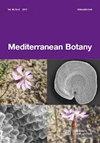对阿尔及利亚东部ssamtifian Tell (Tamentout森林以南)最常用药用植物的植物区系和民族植物学研究作出贡献
IF 0.7
4区 生物学
Q3 PLANT SCIENCES
引用次数: 3
摘要
本研究旨在通过在几个州进行的植物区系调查来了解塔门托森林的自然遗产,并通过在该地区几个地方进行民族植物学研究来评估塞蒂芬泰尔传统医学的使用情况。通过对所列植物区系的定量和定性分析,确定了101种植物,分为38科97属。菊科(19%)、蚕豆科和Lamiaceae科(11%)的一个重要代表。植物区系研究强调了几种生物类型的存在,其中半隐生植物(42%)和兽生植物(31%)共占优势。地中海植物区系元素构成了最重要的合唱组合(52%)。民族植物学调查是在82名知情者中进行的,共有290张问卷卡。所有结果均采用Excel 2007和IBM SPSS Statistics 23版统计处理软件进行处理。这些结果表明,叶子是最常用的部分(43%),使用方法有输液(25%)、膏药(18%)和煎剂(11%)。最常见的使用形式是凉茶(46%)、粉末(25%)和精油(19%)。口服途径是最广泛使用的给药途径(51%)。最常见的病理是消化系统(20%)和呼吸系统(18%)。这项研究使我们有可能确定塔门托南坡森林的植物群多样性,并列出其传统护理,从而为保护正在消失的地中海药典做出贡献。本文章由计算机程序翻译,如有差异,请以英文原文为准。
Contribution to the floristic and ethnobotanic study of the most utilized medicinal plants in the Sétifian Tell (south of the Tamentout forest) east Algeria
This study aims to know the natural heritage of the Tamentout forest through a floristic inventory made in several cantons and to evaluate the uses of traditional medicine in the Sétifian Tell, by conducting an ethnobotanical study at the level of several localities in the region. A quantitative and qualitative analysis of the listed flora identified 101 plant species, which are divided into 38 families and 97 genera. An important representation of the Asteraceae (19%), Fabaceae and Lamiaceae families (11%) are noted. The floristic study emphasizes the presence of several biological types, with a codominance of hemicryptophytes (with 42%) and therophytes (31%). The Mediterranean floristic element constitutes the most important chorological ensemble (52%). The ethnobotanical survey was conducted among 82 informants, with a total of 290 questionnaire cards. All the results were processed by statistical processing software: Excel 2007 and IBM SPSS Statistics version 23. These results showed that the leaves are the most used part (43%) and that the methods of use are prepared in the form of infusion (25%), poultices (18%), and decoction (11%). The most common forms of use are herbal tea (46%), powder (25%), and essential oil (19%). The oral route is the most widely used route of administration (51%). The most common pathologies are those of the digestive system (20%) and the respiratory system (18%). This study made it possible to identify the diversity of the flora of the Tamentout South Slope forest and list its traditional care and consequently to contribute to the conservation of the Mediterranean pharmacopeia that is being lost.
求助全文
通过发布文献求助,成功后即可免费获取论文全文。
去求助
来源期刊

Mediterranean Botany
Agricultural and Biological Sciences-Plant Science
CiteScore
2.40
自引率
10.00%
发文量
30
审稿时长
12 weeks
期刊介绍:
Mediterranean Botany (ISSNe 2603-9109), formerly Lazaroa, is a biannual journal that publishes original research studies in the field of Botany including plant systematics, vegetation ecology, biogeography, evolutionary biology, ecophysiology, community ecology, ethnobotany and conservation biology on Mediterranean biomes but also in interacting areas.
Mediterranean Botany is an OPEN ACCESS Journal, free of charges for any published article.
 求助内容:
求助内容: 应助结果提醒方式:
应助结果提醒方式:


